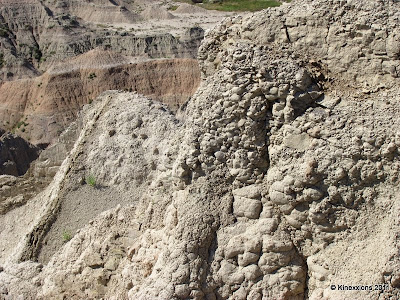The North Unit, sandwiched between Highway 44 and Interstate 90, is the one that the vast majority of visitors see, myself included. The main route through this section is the Loop Road.

I entered the Park on the northwest end, from Wall on route 240. After exploring the Sage Creek area (where I was engulfed by a herd of bison) I returned to the Loop Road and continued eastward.

The Pinnacles Overlook area.






The Ancient Hunters Overlook. This is where evidence has been found that the Ancient Ones stampeded herds of bison over the edge of the cliff and butchered the fallen animals.

Yellow Mounds Overlook.
The yellow and red layers in the formations are fossilized soils, called paleosols. Fossil root traces, burrows, and animal bones found within the soils provide scientists with evidence of environmental and climatic changes that occurred in the badlands over time.


Driving through the Conata Basin.

The Conata Basin. See the car on the road in the lower left corner?

Homestead Overlook.
According to a sign posted at the overlook:
Homesteaders poured into the Badlands when the Milwaukee Railroad completed track through the White River Valley in 1907. Most of the homesteads turned out to be “Starvation Claims” and were abandoned or sold. Starved-out homesteaders moved on to build towns and cities, or to seek another homestead in a land less harsh. Today the ranches of this valley are measured in thousands of acres, and heavy equipment does most of the work once done by callused hands. Even so, unpredictable drought and economic crisis test ranchers today as severely as they tested homesteaders yesterday.

Fossil Trail.

Exiting the park through Cedar Pass.
No comments:
Post a Comment